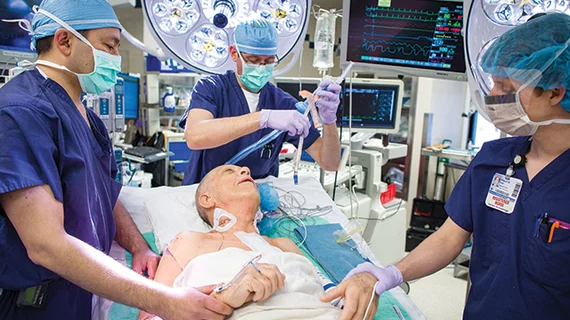A meta-analysis published April 30 in the New England Journal of Medicine supports radial artery grafts over saphenous vein grafts in coronary artery bypass surgery (CABG), showing lower risks for myocardial infarction (MI), repeat revascularization and graft occlusion.
Despite being recommended by current guidelines, the use of multiple arterial grafts in CABG has not been widely adopted, noted lead researcher Mario Gaudino, MD, and colleagues.
“In the United States, less than 10 percent of patients who undergo elective CABG receive more than one arterial graft, and a radial-artery graft is used in less than 7 percent,” wrote Gaudino, of NewYork-Presbyterian and Weill Cornell Medicine in New York, and coauthors. “One of the reasons for their infrequent use is that the superior clinical outcomes associated with multiple arterial grafts that have been reported in registries have not been replicated in the randomized, controlled trials.”
Most of the individual studies were underpowered to detect differences in clinical outcomes, the researchers noted, prompting them to perform a meta-analysis of randomized trials to gain sufficient numbers for such an evaluation.
After pooling patients from six randomized trials, Gaudino et al. studied five-year outcomes from 534 individuals who received radial artery grafts and 502 who received saphenous vein grafts. They found patients receiving radial artery grafts were:
- At a 33 percent lower risk of meeting the primary endpoint: a composite of death, MI or repeat revascularization. Their event rate for those outcomes was 25 per 1,000 patient years versus 39 per 1,000 years in the saphenous vein group.
- Half as likely to require revascularization and 28 percent less likely to experience MI.
- 56 percent less likely to experience graft occlusion.
- At a similar death risk as those who underwent saphenous vein grafting.
“The use of radial-artery grafts was associated with a significantly lower risk of the composite outcome of death, myocardial infarction, or repeat revascularization and with a significantly lower risk of two individual components of the outcome—myocardial infarction and repeat revascularization—at a mean follow-up of five years,” the authors wrote. “The use of radial-artery grafts was also associated with higher rates of angiographic patency at protocol-defined angiography, a finding that offers a biologic mechanism to explain the observed advantage in clinical outcomes.”
According to Gaudino et al., the clinical benefit of the radial artery approach seemed more pronounced in women, patients younger than 75 and those without renal insufficiency.
Regarding the lack of significant survival difference between the groups, the authors noted, “although there is clear evidence that failure of grafts to the left anterior descending artery adversely affects survival, failure of grafts to other target vessels is more likely to result in nonfatal cardiac events.”
Patients enrolled in the trials were highly selected, limiting extrapolation to an all-comers population, the researchers acknowledged. In addition, the included trials used different surgical techniques and postoperative treatment regimens, and only three-fourths of the participants had follow-up angiographic data for the patency analysis.

